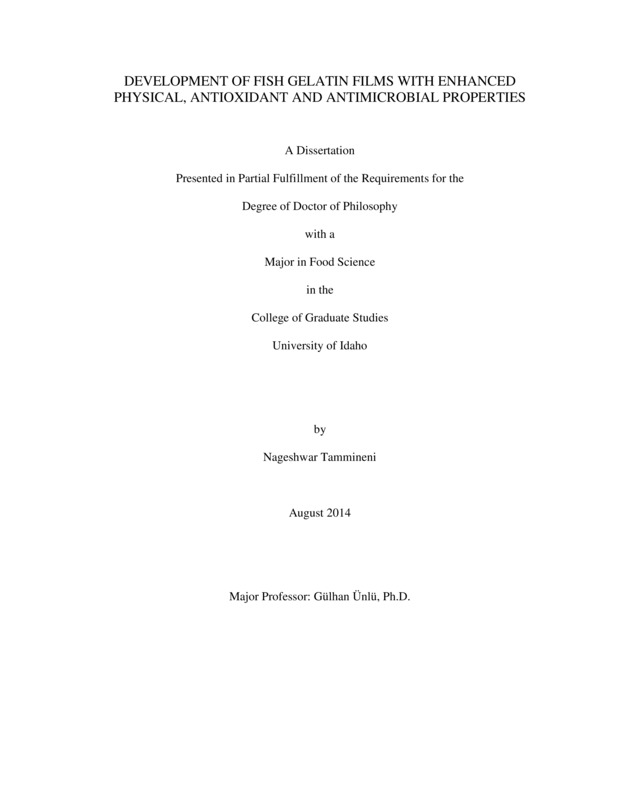DEVELOPMENT OF FISH GELATIN FILMS WITH ENHANCED PHYSICAL, ANTIOXIDANT AND ANTIMICROBIAL PROPERTIES
Tammineni, Nageshwar. (2014). DEVELOPMENT OF FISH GELATIN FILMS WITH ENHANCED PHYSICAL, ANTIOXIDANT AND ANTIMICROBIAL PROPERTIES. Theses and Dissertations Collection, University of Idaho Library Digital Collections. https://www.lib.uidaho.edu/digital/etd/items/tammineni_idaho_0089e_10383.html
- Title:
- DEVELOPMENT OF FISH GELATIN FILMS WITH ENHANCED PHYSICAL, ANTIOXIDANT AND ANTIMICROBIAL PROPERTIES
- Author:
- Tammineni, Nageshwar
- Date:
- 2014
- Keywords:
- Antioxidants Fish gelatin Nisin Oxidation Polyphenols Tannic acid
- Program:
- Food Science
- Subject Category:
- Food science; Packaging
- Abstract:
-
Fish processing byproducts account for a large percent of the weight of total catch. These byproducts can be used for a variety of purposes including gelatin extraction. Gelatin has numerous food and pharmaceutical applications. However, bovine gelatin has traditionally been used for most applications due to its superior properties. Fish gelatin is being reexamined as gelatin source for food applications due to concerns (prion contamination and cultural restrictions) associated with bovine gelatin. This research is focused on improving fish gelatin properties and demonstrating additional uses for fish gelatins by developing antioxidant and antimicrobial films.
First objective involved the development of trout (Oncorhynchus mykiss) skin gelatin films with epigallocatechin gallate (EGCG) (50 and 250 ppm) and green tea powder (1% and 20% wt/wt of gelatin). Films were tested for physical properties, in vitro antioxidant activity and effect on stabilizing cod liver oil held at 40oC for 20 days. Antioxidant activity was retained in films containing green tea powder, but was reduced (P < 0.05) in EGCG films. Physical properties varied with antioxidant incorporation. There was significant increase in the oxidation parameters of uncovered oil compared to treatments.
In the second objective, fish gelatin (6.75% wt/wt) films were prepared at a gelatin:tannic acid ratio (wt/wt) of 1:0.05, 1:0.10 and 1:0.15. Films were evaluated for antioxidant, physical, water permeability and water solubility properties. Comparative data with bovine gelatin was collected. Treatments effect on oxidative stability of salmon fillets was examined at 4 and 10°C. Tensile strength and water solubility of bovine gelatin films varied significantly compared to fish gelatin films. Films with tannic acid possessed antioxidant activity. Treatments lowered oxidation (TBARS values) in gelatin coated refrigerated salmon held for 12 days under refrigerated temperatures.
Trout skin gelatin films were developed with nisin (18 μg nisin/cm2 film) in the third objective. Trout fillets were challenged with 2 log CFU L. monocytogenes/g before or after coating with nisin-containing films. Growth of L. monocytogenes was monitored for 30 days at 4 and 10°C. Films with nisin reduced L. monocytogenes counts below the detection limit (1 log CFU/g) at 4°C. The effectiveness of treatments varied with storage time and temperature.
- Description:
- doctoral, Ph.D., Food Science -- University of Idaho - College of Graduate Studies, 2014
- Major Professor:
- Unlu, Gulhan
- Committee:
- Rasco, Barbara; Powers, Joseph; Moller, Gregory
- Defense Date:
- 2014
- Identifier:
- Tammineni_idaho_0089E_10383
- Type:
- Text
- Format Original:
- Format:
- application/pdf
- Rights:
- In Copyright - Educational Use Permitted. For more information, please contact University of Idaho Library Special Collections and Archives Department at libspec@uidaho.edu.
- Standardized Rights:
- http://rightsstatements.org/vocab/InC-EDU/1.0/

